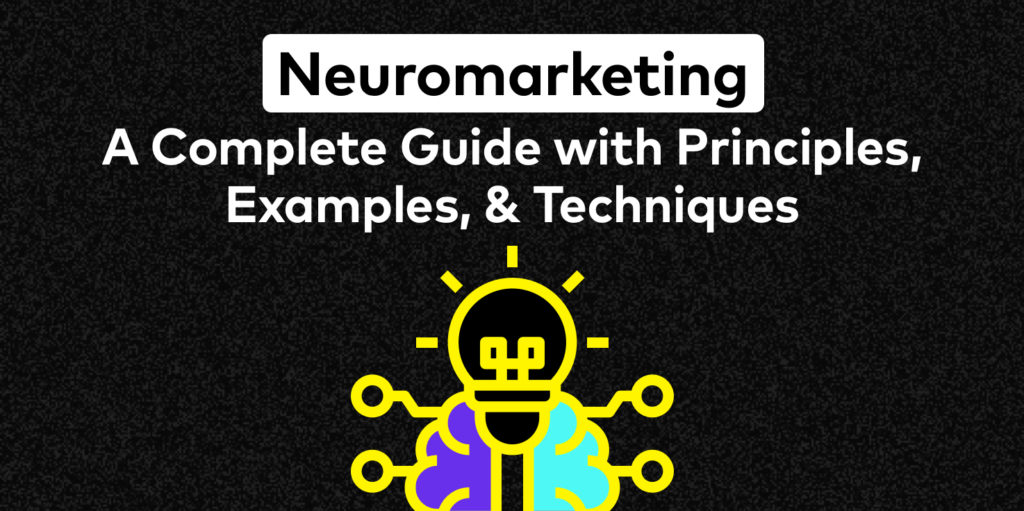NEUROMARKETING TECHNIQUES AND EXAMPLES | Manish SEO Blog
Image Source: https://nogood.io/
Who has not bought something on impulse? How many of us have not made an unconscious purchase, difficult to justify, the result of an unidentified origin? What is known as neuromarketing deals with the relationship between the processes of the human mind when shopping, and how the most emotional part of our brain influences. Thanks to the application of scientific techniques to study this behavior, brands can predict the actions of consumers and design appropriate strategies and techniques.
Also Read: Top 10 Fantasy Cricket Apps List in 2024
In the end, the goal that neuromarketing achieves is to know how consumers think in order to convert them into future customers.
1. What is it: Origin of neuromarketing
It was in the early 1980s that companies began to apply their knowledge of how the human brain works to marketing. The scientists established that the performance of consumers is largely determined by the unconscious and emotional performance of human beings. If we knew how to determine their behavior and predict general patterns, the entire process of selling a product or service could be configured by following those stimuli. To this end, companies began to introduce these teachings and deepen this knowledge of marketing.
2. What is neuromarketing for?
We can summarize the purpose of neuromarketing in the following points:
- Optimize the communication process of a product, using techniques that take into account factors that affect the senses of the human being.
- Provoke purchase impulses by studying consumer behavior.
- Direct and lead the consumer towards the objective desired by the brand, filing barriers and objections to the purchase based on emotional and sensory studies.
3. Forms of neuromarketing study
There are many different ways and means to study the behavior of the human brain and the sensory responses that are activated. Among others, we can point out the following:
- Eye-tracking: The monitoring carried out by the human eye within a web page is studied, for example. With this, the heat maps are constructed.
- Face coding: A study of a person's gestures is carried out to find out how the brain is reacting to different stimuli.
- GSR: This is what is known as the galvanic response in the skin, which is the same as studying the skin reaction as an external representation of internal sensations.
- Electrocardiogram, encephalogram, magnetic resonance ... all kinds of "medical" tests with the aim of measuring different parts and organs of the human body, in their manifestation or changes to what happens in their environment.
4. Practical applications of neuromarketing
The studies that are carried out within neuromarketing, or what is not classified as such, but that study reactions and unconscious stimuli of the consumer have notable practical applications. Applications that have been using brands for years to increase and encourage purchase.
Does anyone think that the placement of products in a supermarket does not follow a perfectly studied order? Well, you are wrong. It is evident that the basic necessities are usually placed at the bottom of the surface, with the aim that you have to go through the entire establishment and add other products to the shopping cart. In the same way, pleasant music and good smell are resources that stores apply so that the degree of customer comfort increases, creating the most conducive context to create positive sensory stimuli.
The placement of the products on the shelves also follows a definite interest. It is common to find the most interesting products for the establishment, either for their price or for their profitability, at the level of the customer's eyes. Leaving the least profitable products at the top or bottom.
5. Color and neuromarketing
It is also clear that the reaction we have to different colors has a lot to do with the unconscious and our own cultural and vital identity. The meanings of the colors vary between countries and different geographical areas of the world.
In the Western world, to which we belong, we do have a classification already well studied in relation to the different meanings:
- Orange: Joy, innovation, energy, fun ...
- Green: Renewal, growth, youth, organic, nature ...
- Blue: Strength, serenity, intelligence, rest, confidence, calm ...
- Red: Love, heat, passion, power, spontaneous, danger, sex ...
- Yellow: Optimism, tranquility, hospitality, creativity ...
- Purple: Mystery, sophistication, luxury, fashion, frivolity, exotic ...
- Rosa: Illusion, childhood, delicacy, courteous, sweet, charm ...
- Brown: Cozy, stable, ordinary, rustic, warm….
When selecting the corporate colors for your company, your logo, spaces, offices ... take into account the meanings of the colors and choose the most appropriate to your product, message, tone, and target audience. Everything will influence the feeling you transmit and the unconscious links that the consumer gives.
6. Neuromarketing in the design of a web page
We are going to focus on the application that we can make of neuromarketing in the design, usability, and CRO within a web page, although it would be applicable to any visual element of our marketing campaigns.
In the end, the intention will always be that the conversion rate increases and that consumer find the least number of negative elements to finish in the objective that we have set.
- Testimonials: The resource of using testimonials on a website that guarantees the professionalism or quality of a product or service is one of the most used assets.
These supposed real comments (it goes without saying that it is better that they are real) are tremendously influential and act as “social proof” that serve to endorse a purchase decision. For example, if you have a digital marketing company, your website must have a testimonial section that reflects your client’s thoughts on your service.
- Provide reasons: If we want the consumer to break down the obstacles they find to complete the purchase, one of the best resources is to provide reasons.
If we give the product or service we offer the appropriate reasons to buy it, the consumer will feel their decision supported. Booking is one of the most obvious examples of the use of this resource.
- Trust through certifications: When we visit a web page and see endorsements or certificates of the service they offer, we tend to be calmer. Their origins may be more or less known, but it is indisputable that certain tranquility looms in our heads.
Look for those certificates and you will surely get a reward
- Engagement of social networks and comments: In the same way, placing the buttons of social networks and seeing the number of times it has been shared, will serve as a social endorsement of what we are seeing. Also viewing comments on a blog can help to promote the idea that these articles are alive and interesting.
- Play with prices: We have already commented on this previously, but when adding the price to a product, we can use several resources. The well-known one from '99 has a successful and well-measured psychological effect. Also, when we offer a service or product with different functionalities, the intermediate price technique is widely used. We place a higher price, a lower price, and an intermediate price, which will be the one that interests us to buy or to which we will direct them to buy.
In the comparison, the higher price will be seen as excessive, the lower price will raise the doubt of whether it will have the functionalities we need, and the average price will be the one that will offer us more peace of mind to finalize the purchase.
- Feelings of urgency: Who has not entered Booking, has gone to make a reservation, and has missed the “last room in this hotel”, “bargain” or “offer only available today” warnings? They are the masters of psychological effects on their website. Also Amazon and other large e-commerce play with these messages. And they work, needless to say. If you have an online store, it is already taking time to add these feelings of urgency that cause that impulse to finish the purchase and not miss the opportunity.
- Reward the user: Another way to earn the consumer's trust is to post messages where they feel rewarded and chosen. When performing an action or search, you can add phrases such as “Congratulations, you have found the best price. Enjoy the offer". Booking does it and it works very well for him.
- Trial periods: Another great resource that works many times. They offer you a trial period, totally free, and if the product is good, you get used to using it, and you can no longer live without it.
A good example would be Netflix. You have a free month that, in a high percentage of cases, becomes a permanent subscription. Netflix does not mean anything to offer that month for free, and the performance it gets is spectacular.
- Make it simple for the user: On the internet, we are all impatient. The more you simplify the actions that the user has to perform on a web page, the better. The forms that must be filled out make them have the correct and necessary fields. A lot of shopping carts are abandoned because of finding a step where you have to fill in a form with too many boxes.
Try not to ask for all those fields until the moment it is necessary for the shipment, for example, not before. And it even offers the possibility that they can make the purchase without having to register. Also, in another sense, simplicity can help you. It is proven that when we offer a product with many characteristics, without highlighting the most important ones, the consumer can become overwhelmed by so much data and slow down the purchase process.
Try to highlight a maximum of the 3 most important characteristics of the product or service, and add the others in a less preferred place or with a "more information" button. Also if the consumer has to choose between dozens of products with similar characteristics, the answer may be negative. Try to point out the ones that interest you the most. The more options, the more doubts may arise.
7. Conclusion
Here we have made a summary of what neuromarketing means and some basic applications and techniques that we can use. But it is a very broad and exciting area, where if you want to go deeper you will have to go to the books on the subject. Also on YouTube, you can find numerous videos that talk about this discipline of marketing.




Comments